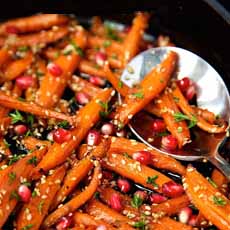TIP OF THE DAY: More Ways To Enjoy Carrots
|
What’s up, Doc? The humble carrot, dressed to impress. Winter, with its paucity of produce choices, is the best time to enjoy root vegetables. The most familiar—and the easiest to convince family members to eat—is the carrot. Here, some ideas from the familiar to the less so. First… A BRIEF INTRODUCTION TO ROOT VEGETABLES Root vegetables most common in the U.S. include the beet, carrot, celery root (celeriac), Jerusalem artichoke, garlic, kohlrabi, onions (use baby onions), parsnips, potato (use small waxy potatoes), radishes, rutabaga, salsify, and turnip. Root vegetables are high in vitamins and minerals, which they absorb from the ground. Many are high in vitamin A, B complex and C; plus antioxidants. Root vegetables are an excellent source of fiber. Many of these can be eaten raw, steamed, sautéed, baked, roasted, stir fried, or fried. In the case of carrots, Whether baby, heirloom or standard, carrots and their root kin are waiting at your nearest market. COOKING CARROTS Beyond boiled carrots, carrot salad and crudités, consider these preparations: Different choices here: Roasted carrot or mixed roasted vegetable sandwich, with or without goat cheese; or carrot pickles or carrot slaw on a ham, turkey or other sandwich. If it’s not listed here, please let us know! CARROT HISTORY The original wild carrots were white, like parsnips. According to Colorful Harvest, marketer of rainbow carrots, the cultivated purple and yellow carrots—mutations—were eaten more than 1,000 years ago in what is now Afghanistan. Other colors are the product of generations of traditional plant breeding. Orange carrots were first successfully bred in Holland from an orange mutation by Dutch farmers. Here’s the history of carrots. FROM WHERE DO CARROTS GET THEIR COLOR? |

[1] “Cooked” carrot salad. Here’s the recipe from Walnut Frog. [2] Carrots with other root vegetables (here, radishes and baby onions). Here’s the recipe, with a maple-honey glaze, from Kalamazoo Gourmet. [3] Pan-fried carrots with parsley. Not the red skin: It’s an heirloom variety. Here’s the recipe from The Nourishing Gourmet. [4]. These glazed carrots are accented with sesame seeds and pomegranate arils for more color. Here’s the recipe from The Café Sucre Farine. [5] Grilled carrot sandwich on crusty bread with goat cheese, apricot jam and toasted pine nuts, at The Wayfarer | NYC. [6] This picture is not Photoshopped: These are natural mutations. See how it happens, below (photo courtesy The Wayfarer). |
|
|
Deeply colored produce are rich in nutrients, including antioxidants. Different antioxidants produce the different colors or carrots: †Other common root vegetables, that don’t necessarily lend themselves to these preparations, include include daikon, ginger, horseradish, jicama and turmeric.
|
||




